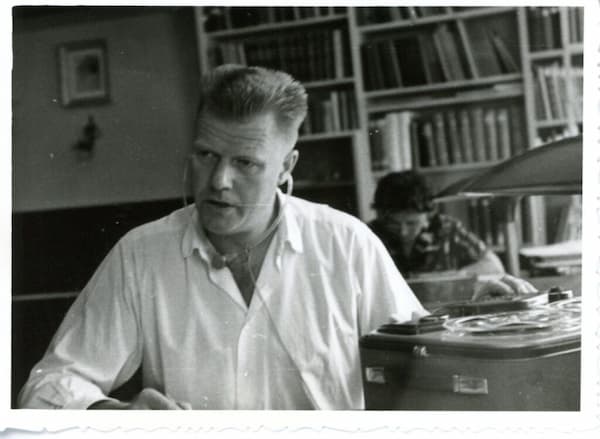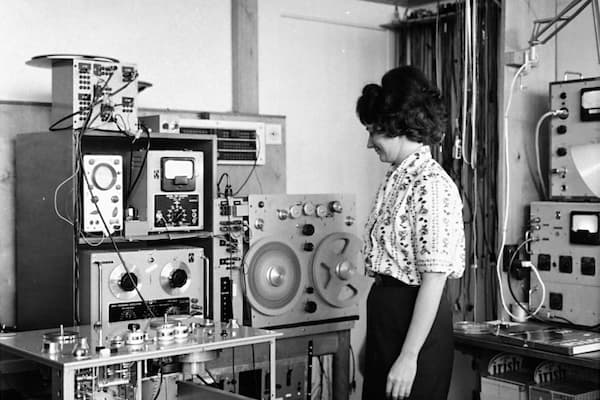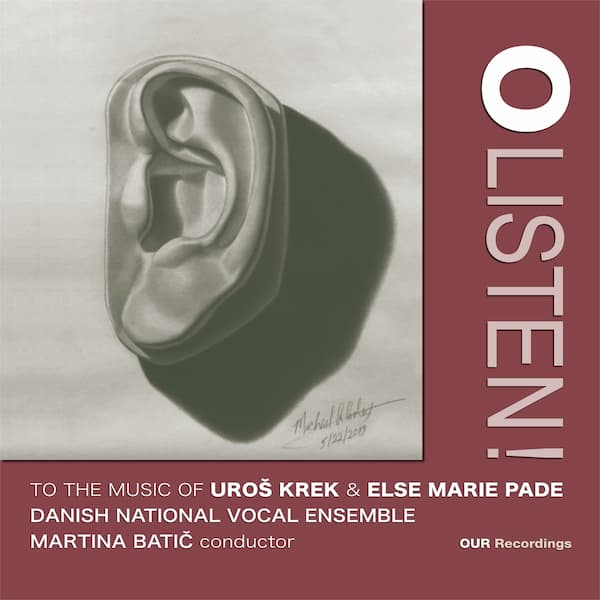OUR Recordings release of O Listen! To The Music of Uroš Krek & Else Marie Pade, performed by the Danish National Vocal Ensemble, Martina Batič, conductor, brings us the music of two composers who were contemporaries and were nurtured by similar institutions but went completely different ways in their compositions.

Uroš Krek

Else Marie Pade
Uroš Krek (1922–1968) was a Slovenian composer whose first position was at Radio Slovenia, where he eventually became editor-in-chief of the music program. Following that job, he taught at the Institute of Ethnomusicology of the Slovenian Academy of Sciences and Arts, where he collected and studied Slovenian folk music. Following that, he was professor of composition at the Ljubljana Academy of Music. All of these experiences gave him a background in radio, experience in Slovenian vocal music, and a hand in composition. His works, such as Samotno ugibanje (Solitary Speculation) from 1987, rev 1998, picked up on the ‘veiled cheerfulness and acerbic bitterness of the Slovenian soul’.
Uroš Krek: Samotno ugibanje (Solitary Speculation)
The text, by Jože Udovič (1912-1986), asked questions that all begin ‘Who knows…’. Who knows what lies under your feet? Who knows if something that seems frozen contains life? Who knows if what appears to be good is bad? Who knows if a singer can sing the end of the world? The questions are not to be answered but are the thoughts of a wandering philosopher, seeming to look behind the surface of appearances. Krek’s setting starts with the whole ensemble and ends with the low voices as the single wanderer.
Krek set songs in English (such as the 3-song cycle of Three Autumn Songs by John Gracen Brown (b. 1936), in Slovenian, and in Latin, including Psalm 42 and a song to the Grecian muses (Vester, Camenae (I am yours, Muses)).
Else Marie Pade (1924–2016) made her name as Denmark’s first electronic music composer. This recording looks at 3 decades of her vocal work, starting with Korsatser, three songs written between 1951 and 1955. Originally for solo voice with piano accompaniment, the cycle was arranged by John Høybye in 2008 for choir. When it was originally arranged for choir, an electronic soundtrack was created at the same time, started by the composer and completed by Stephan Bomberg. The electronic backing track contained excerpts from three of Pade’s works: Faust, Et glasperlespil, and Havkongens Slot. It was omitted for this recording, however, which uses the 2024 arrangement by John Høybye.
Völo-spa hoc est (This is the Prophecy of the Völva), a work from 1956, started with a 9th-century Icelandic poem, ‘Vølvens spådom’, in this setting for a 4-part women’s choir. ‘In the poem, Odin, King of the Gods, asks his female spiritual guide, Vølven, to look into the future. In a trance, she predicts the end of the world in Ragnarok and, at the same time, the fall of the Gods. This was one of Pade’s last major works before electronic music became her genre of choice. The original poem in Islandic has over 60 stanzas. In this Latin version, it’s only 8 verses but still takes us from the living earth to the dragon that eats the world.
The final work on the recording is Maria, written in 1980 for coloratura soprano, bass-baritone, speaking choir and 7 trombones, together with electronics (as sound files). The electronic part had been created by Pade in 1972 from her own recordings of prepared piano sounds. The church bell-like sounds were created electronically. The electronic sounds are played through a column of loudspeakers, and the sound for each movement gradually rises towards the skies.
The work is structured around the Apostles Creed and consists of 11 movements that portray the stages of the Virgin Mary’s suffering. The movements reflect her journey from the joy and wonder of Jesus’ birth (To be worshipped, To love, To wonder), through the anguish of his Crucifixion (To suffer, To grieve), to a longing for his return and faith in divine justice (To desire, To judge). This leads to a revelation of religious mysticism, where Mary embraces the Holy Spirit, the power of prayer, and a sanctification that transcends death, allowing her to attain eternal life (To know, To pray, To sanctify, To live).
It is considered the greatest of Pade’s religious works, created when religion was becoming an important part of post–WWII trauma recovery. The final movement, ‘Vivere (To live)’, becomes the apotheosis of resurrection, with each section rising and rising.
Else Marie Pade: Maria – XI. Vivere (To Live)
Electronic music in a religious setting is a rarity and it’s interesting to hear what Pade does with the few words of the Apostles’ Creed in creating this work. She doesn’t pull back from her creation but exploits all the possibilities of the new electronic genre. In addition to the electronic backing track and the bells, the part for the speaking choir has also been treated electronically. Each spoken choral section is first heard electronically, then whispered, then with added echo.
The combination of the two composers, one Slovenian and one Danish, both of whom learned important parts of their craft at their national radio stations. They were born within two years of each other but developed such strikingly different choral styles that this recording is less about their work than the broad definition of what a choral ensemble could do in the 20th century.

O Listen! To The Music of Uroš Krek & Else Marie Pade
Danish National Vocal Ensemble, Martina Batič, conductor
OUR Recordings, 8.226924
For more of the best in classical music, sign up for our E-Newsletter
